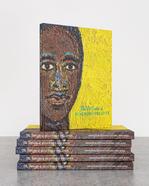“[Beauford] Delaney repeatedly turned to art to annihilate the boundaries of fixed identity in ways that were not simply aesthetic…but also spiritual. Such ecstatic annihilations ran between his purely abstract paintings and his portraits, animating his figurative and non-figurative work alike."[1] —Mary Campbell
“[I] have worked terribly hard…and much has sundered and exploded, but now it coalesces with lava-like smoke and fluid color, sometimes a veritable flame, other times subdued essences…yes, I am again painting in my old feeling—tense, difficult, but compulsive, and I love it.”[2] —Beauford Delaney, 1964
Michael Rosenfeld Gallery is pleased to announce its third solo exhibition of paintings by Beauford Delaney (American, 1901–1979), which will contextualize the artist’s highly personal portraiture practice in relation to his compelling body of non-objective abstractions.
Featuring 25 portraits and 7 abstract works, Be Your Wonderful Self: The Portraits of Beauford Delaney explores the preeminent status portraiture held in the artist’s life and work, following the trajectory of his career from his “Greene Street” period in New York through his ardent embrace of pure abstraction after his relocation to Paris in 1953. By exhibiting Delaney’s portraiture alongside his abstractions, the exhibition seeks to reveal the common intention with which the artist approached both genres of painting, which came to dominate his artistic output for the remainder of his working years. Be Your Wonderful Self will be accompanied by an expansive catalogue, publishing new scholarship by Mary Campbell, Associate Professor of Art History at the University of Tennessee, Knoxville, and an illustrated chronology featuring an extraordinary selection of previously unpublished archival photos and ephemera. A special section of the publication will be dedicated to statements from such historical and contemporary voices as James Baldwin, Richard Long, Julie Mehretu, Georgia O’Keeffe and Amy Sherald, who describe the indelible impact Delaney’s work had on their practices and the broader evolution of 20th century modernism.
The scope of Be Your Wonderful Self encompasses Delaney’s mature career, beginning with his masterful early portrait of a young James Baldwin, Dark Rapture (1941), and terminating with his penetrating 1972 depiction of Jean Genet. Though its acclaim is well-earned, Delaney’s technical mastery often eclipses his singular ability to capture individual temperament in his portraits—a capacity often augmented by the artist’s sincere and unconditional engrossment in his sitters. His distinctive formal approach to portraiture melds abstraction and figuration in such a way that the physical description of the sitter is secondary to their psychological essence; by emphasizing specific characteristics of their form (often including clothing or expression) Delaney renders each subject as an iconographic manifestation of their interior self. His bold fauvist palette and meticulously textured surfaces, which range from densely encrusted to ethereally sheer, unifies subject and background in a way that overshadows their corporeal presence, rendering each painting a new, holistic embodiment of its subject. Delaney often worked from memory when painting portraits, an approach that imbues his pictures with a particular subjectivity rooted in the artist’s emotional and psychic relationship with his subjects; far from a narcissistic impulse, Delaney embraced this approach as a means to making the imperceptible connection between artist and subject visible through a combination of formal exaggeration or simplification expressed through a meticulous chromatic exactitude.
Delaney’s abstractions were likewise conceived in his studio without a physical referent present—usually with the walls and other works in the space covered by white bedsheets to enhance the effects of the natural light—and testify to the intense drive for aesthetic experimentation he felt unable to adequately express in his figural works. Considered by the artist to be individual expressions of ineffable emotional or cosmic profundities, the abstract works often acted as a receptacle for the overflow of creative passion that overwhelmed the artist after settling in Paris. By exhibiting these parallel bodies of work in conversation with each other, Be Your Wonderful Self seeks to reveal the conceptual crux that unifies them, namely the arresting treatment of tone and atmosphere inherent to the artist’s entire oeuvre. As critic and poet Jean Guichard-Meili wrote in a review of the artist’s 1964 exhibition at Galerie Lambert, “Only a methodical and extended exercise of vision will permit [the abstract paintings] to be sensed and savored amid and beneath the network of color tones…the movements of internal convection, the vibrations of underlying design. The portraits do not differ from the other works…Background, clothing, hands, face are the pretext for autonomous harmonies.”[3]















































